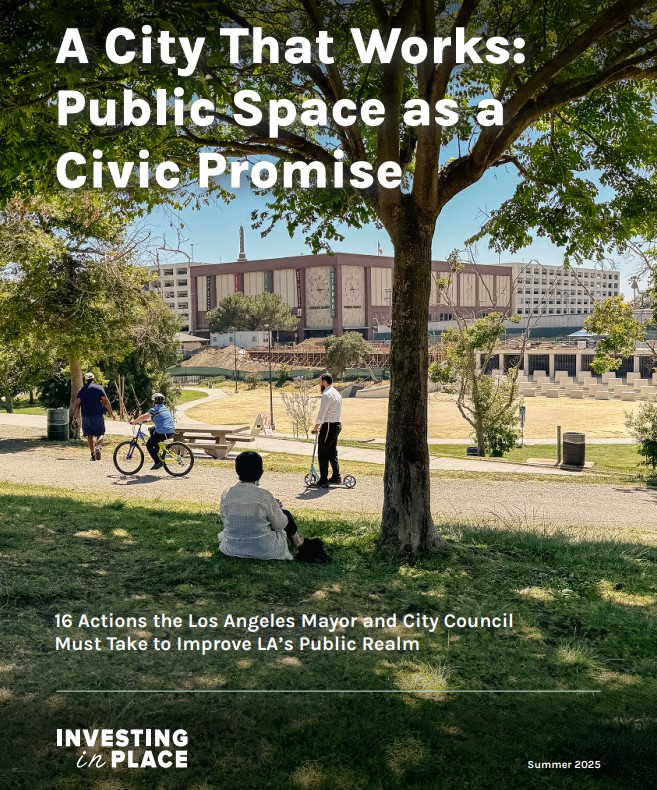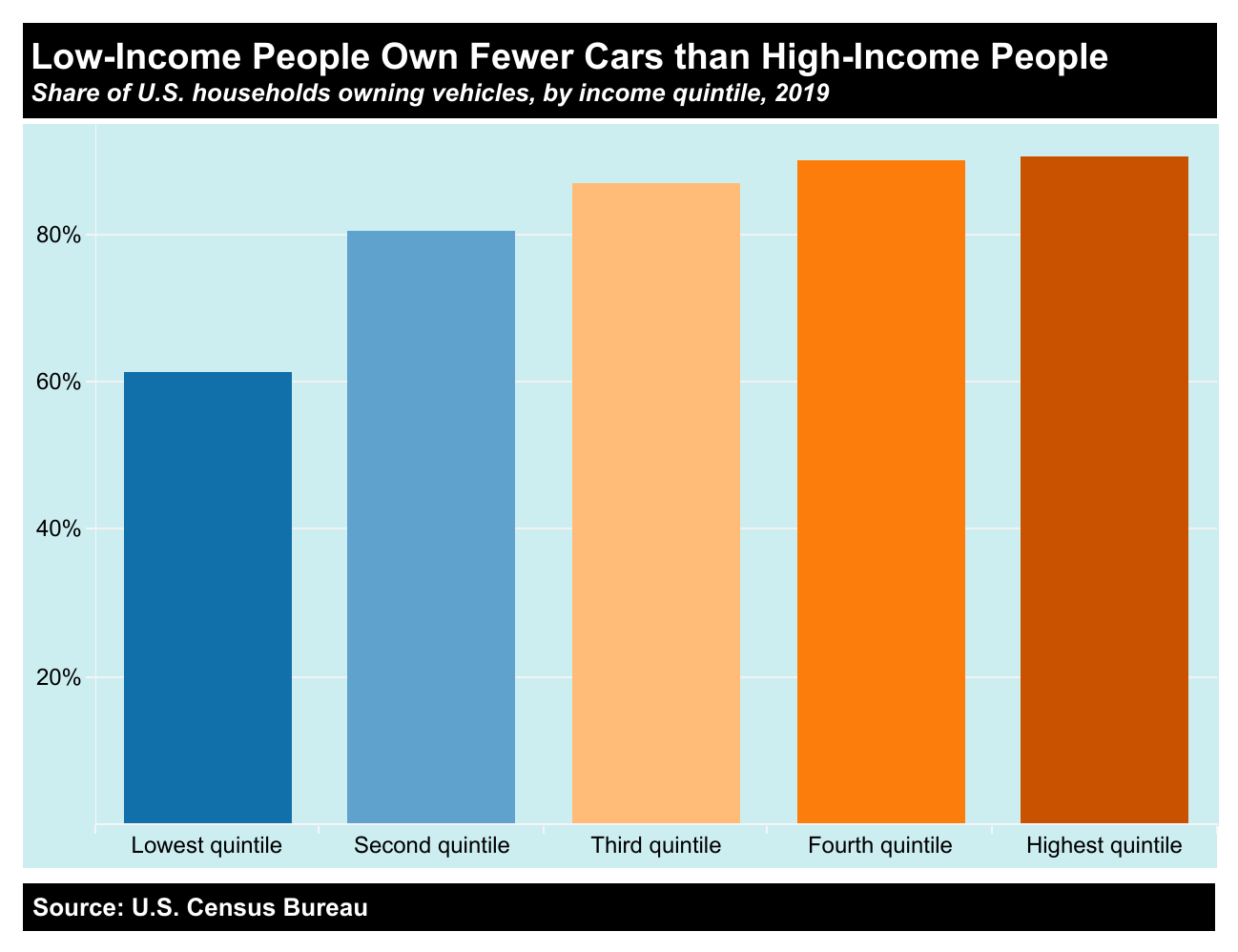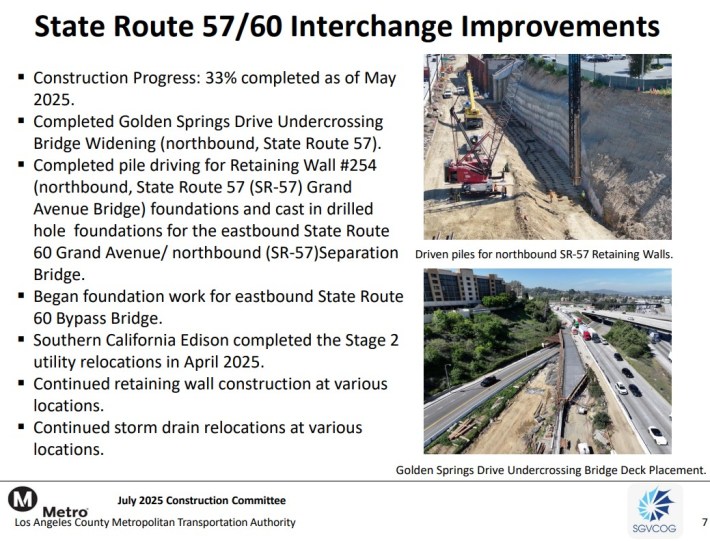Editor's note: This post first appeared on Inequality.org and is republished with permission.
For decades, the federal government has allocated about four times as much funding to roadways as it has to public transit such as buses and subways.
This policy choice has consequences for racial and economic justice, the environment, and more. Here, we focus only on the racial and economic justice questions — whose interests are not served, and who are excluded, by the policy choice to prioritize an ever-expanding roadway system over public transit?
When the federal government pours money into highways and starves public transit of resources, an inevitable consequence is that the road network keeps expanding, and public transit systems face resource constraints that impact their operation.
Between 1990 and 2020, the extent of roadways in the U.S. measured in lane miles grew by 9 percent. (One lane of roadway over a one-mile length is one lane mile. Thus, a 10-mile length of a four-lane roadway is 40 lane miles, and a 20-mile length of a two-lane roadway is also 40 lane-miles.)
However, what this overall number masks is the dramatic growth of urban roadways. Even as the overall extent of rural roadways shrank by almost 6 percent over this period, urban roadways overall expanded by almost 67 percent, and urban interstate highways in particular expanded by almost 73 percent. Federal transportation funding has subsidized urban sprawl.

Meanwhile, public transportation systems have an accumulated maintenance and repairs backlog that is estimated by different sources as between $90 billion and $176 billion. The $39 billion in new transit funding provided by recent federal infrastructure legislation is less than half of the lower estimate of this maintenance backlog (and less than a quarter of the higher estimate).
When transit systems are poorly maintained, the frequency and reliability of service suffers, making transit a less viable form of personal transportation. Faced with unreliable (and for as many as 45 percent of people in the U.S., non-existent) transit systems, people often have no choice but to drive a personal vehicle to get to work, medical appointments, the grocery store, or anywhere else. Who does this impact?
Who Are the Carless?
Obviously, in a society where ownership of a personal vehicle is essential for basic personal mobility, those without a vehicle (about 18 percent of all U.S. households) are excluded. But the degree of exclusion can be far worse for some people.
Personal vehicle ownership rates by households are distinctly lower for people of color than for white people, as seen from U.S. Census Bureau data. Barely more than two-thirds of Black households own vehicles, compared to about 82 percent of all households and 86 percent of white households.
The same data show even more striking disparities in vehicle ownership by household income, with only 61 percent of households in the lowest income quintile owning a vehicle, compared to 90 percent of households in the highest income quintile. (A quintile is one-fifth of a distribution. If all household incomes in the U.S. were arranged in order from the lowest to the highest, the lowest one-fifth of household incomes would be called the lowest income quintile, the next one-fifth would be called the second quintile, and so on.)

A transportation system that assumes universal private vehicle ownership denies basic mobility to two out of five of the poorest one-fifth of U.S. families.
But what about households that do own vehicles? Costs such as gasoline, vehicle insurance, and maintenance and repairs add up to a significant share of income for lower-income families. For the poorest 10 percent of U.S. households, the share of after-tax income going to vehicle costs (22.6 percent) is 7.5 times as large as the share spent on vehicle costs by the richest 10 percent.
A transportation system where people have to rely on their own vehicles doesn’t merely exclude those who don’t own vehicles – it imposes a severe financial burden on poorer households that do own vehicles.
U.S. transportation policies privileging roadways and personal vehicles over all other modes of travel have not served the economic and transportation needs of all. They are a public subsidy for disproportionately white, wealthier households, at the expense of the rest of the population.
Transit Creates Good Jobs
Transforming U.S. transportation policy priorities from its current overemphasis on (and excessive funding for) roadways at the expense of all other forms of transportation will clearly serve the needs of people of color and low-income people by providing them more affordable and accessible mobility choices that don’t require them to own cars. But such a transformation will also create another important economic benefit for these currently underserved communities, in the form of good jobs.

Transit jobs are good blue-collar jobs, with high wages compared to the economy-wide average. Subway and streetcar operators, for example, have a median wage of $33.38, which is more than 50 percent higher than the median wage for all U.S. occupations. Even entry-level transit workers make relatively high wages. Subway and streetcar operators who are in the bottom 10 percent of wage earners in their occupation earn a median of $19.66 per hour. That’s nearly twice the median for workers in the bottom 10 percent wage group for all U.S. occupations.
Following the Money
Shifting U.S. transportation priorities away from their disproportionate focus on highways and towards public transit would actually serve the interests of people of color and low-income people, by improving mobility options for people who don’t own vehicles, and people for whom owning and operating a vehicle is a serious financial burden. Why, then, has this shift not happened?
Unsurprisingly, that’s partly attributable to industry lobbying pressure, backed by campaign money. For the oil and gas industry in particular, highway-centric transportation is a gift that keeps on giving, because it provides a captive market for their product. Lack of other dependable transportation options compels people to drive everywhere, boosting sales of gasoline and diesel.
We know this anecdotally, through an Exxon lobbyist bragging to undercover investigative journalists that the company lobbied to turn the American Infrastructure and Jobs Act (popularly known as the Bipartisan Infrastructure Bill) into a “highway bill.”

But we know this more definitively as well. Political campaign contributions by the oil and gas industry over the last five election cycles (2012 through 2020) have totaled $485 million, including $140 million in the last election cycle alone.
In the current (2022) election cycle, a huge share of oil and gas money has gone to just one politician – Sen. Joe Manchin (D-WV). The industry’s campaign contributions to Manchin are nearly four times their contributions to the next highest recipient.
Manchin was part of the group of Senators who came up with the Bipartisan Infrastructure Bill, and one of its most vocal proponents. And the bill continues the longstanding practice of allocating a disproportionate share of funding to highways at the expense of other modes of transportation.
Clearly, fossil fuel interests are rewarding him for serving their interests.
Transit Equity Day
On February 4 (Rosa Parks’ birth anniversary), a network of transit rider organizations, unions, civil rights organizations, and climate and environmental justice organizations will observe the fifth annual Transit Equity Day, lifting up demands for affordable, accessible public transit for all, powered by electricity from renewable sources, and with good union jobs.
Transit Equity Day is a great opportunity to publicly challenge the flawed policy priorities that create and maintain our exclusionary transportation system, and advocate for just, inclusive transportation for the benefit of people and the planet. See this events listing page for Transit Equity Day events near you.
Basav Sen directs the Climate Policy Project at the Institute for Policy Studies.







